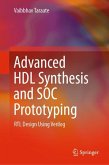This book collects the best practices FPGA-based Prototyping of SoC and ASIC devices into one place for the first time, drawing upon not only the authors' own knowledge but also from leading practitioners worldwide in order to present a snapshot of best practices today and possibilities for the future. The book is organized into chapters which appear in the same order as the tasks and decisions which are performed during an FPGA-based prototyping project. We start by analyzing the challenges and benefits of FPGA-based Prototyping and how they compare to other prototyping methods. We present the current state of the available FPGA technology and tools and how to get started on a project. The FPMM also compares between home-made and outsourced FPGA platforms and how to analyze which will best meet the needs of a given project. The central chapters deal with implementing an SoC design in FPGA technology including clocking, conversion of memory, partitioning, multiplexing and handling IP amongst many other subjects. The important subject of bringing up the design on the FPGA boards is covered next, including the introduction of the real design into the board, running embedded software upon it in and debugging and iterating in a lab environment. Finally we explore how the FPGA-based Prototype can be linked into other verification methodologies, including RTL simulation and virtual models in SystemC. Along the way, the reader will discover that an adoption of FPGA-based Prototyping from the beginning of a project, and an approach we call Design-for-Prototyping, will greatly increase the success of the prototype and the whole SoC project, especially the embedded software portion. Design-for-Prototyping is introduced and explained and promoted as a manifesto for better SoC design. Readers can approach the subjects from a number of directions. Some will be experienced with many of the tasks involved in FPGA-based Prototyping but are looking for new insights and ideas; others will be relatively new to the subject but experienced in other verification methodologies; still others may be project leaders who need to understand if and how the benefits of FPGA-based prototyping apply to their next SoC project. We have tried to make each subject chapter relatively standalone, or where necessary, make numerous forward and backward references between subjects, and provide recaps of certain key subjects. We hope you like the book and we look forward to seeing you on the FPMM on-line community soon (go to www.synopsys.com/fpmm).
Hinweis: Dieser Artikel kann nur an eine deutsche Lieferadresse ausgeliefert werden.
Hinweis: Dieser Artikel kann nur an eine deutsche Lieferadresse ausgeliefert werden.








